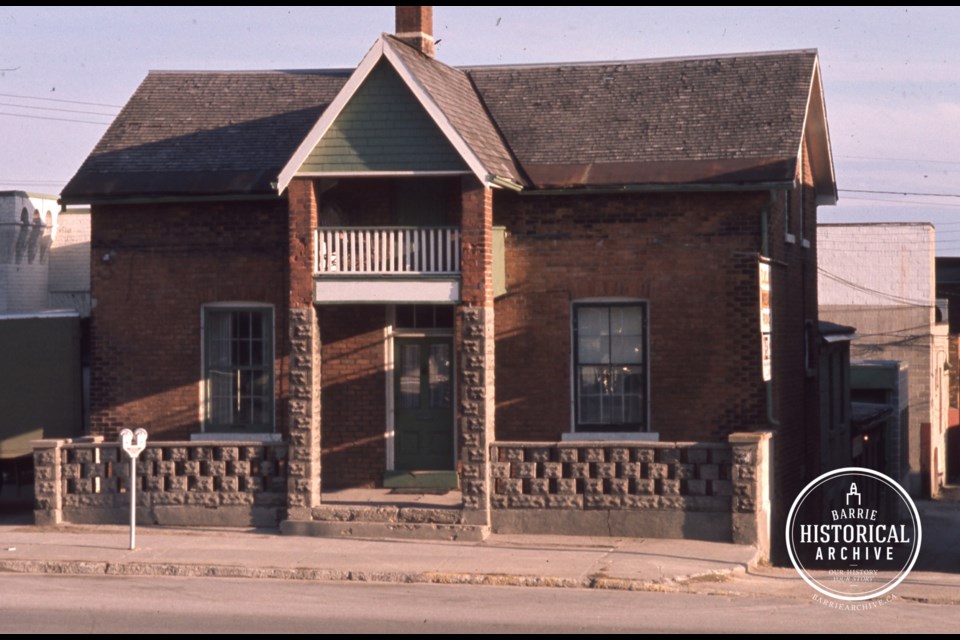This ongoing series from Barrie Historical Archive curator Deb Exel shows old photos from the collection and one from the present day, as well as the story behind them. This week, Deb writes about Cancilla Fruit Market, with some help from fellow Archive collaborator Mary Harris.
Cancilla Fruit Market — 21 Collier St.
Mary Harris: Cancilla’s is closed.
Me: I know. We should write about the house. I have photos.
Cancilla’s fruit warehouse, located at the back of 21 Collier St., may be the last place the longtime family business operated, but it’s not their first. The Barrie Fruit Market started at the corner of John Street (now Maple Avenue) and Elizabeth Street (Dunlop Street West) and moved around the downtown core over the years: Five Points, Clapperton Street, the old opera house and their final address at the rear of 21 Collier St. For more about the Cancilla family, please read on.
Before Cancillas arrived, there were other businesses that had hung their shingle at 21 Collier St.: Barrie Press in the 1950s and '60s, the Canadian Cancer Society and McCann’s Auto Electric in the mid-1960s, Calvert Wholesale in the 1970s, Gregg Signs in the 1980s, then Huronia Process Services and Prestige Signs in the 1990s.
While the businesses came and went, the house continued to offer apartment units.
The area around 21 Collier appears pretty commercial now, but in the '70s there were still a few homes or repurposed homes dotting Collier Street, west of Mulcaster Street. Here’s a few memory joggers of one-time dwellings that would have been neighbours to our little house at 21 Collier at that time: Colkan Real Estate, Jerry’s TV, the Beauty Box Salon, Chau’s Chinese Food, the homes of the Fishers and the Simpsons, a few more houses on the south side of Collier, and a historic apartment house that had stood since the 1800s.
Mary tells this story of 21 Collier and its people:
Little houses. We pass them by every day, never giving them much thought, until one day we realize that their days are numbered and soon they will be no more.
Who lived there and what did they do? Did they live happy lives within these walls?
Before the barricades go up, and the demolition crew arrives, let’s take a look at 21 Collier St. A conjoined twin to the Cancilla Fruit Market warehouse, now also condemned, this house once stood in the shadow of the Grand Opera House, its neighbour to the east.
Imagine the comings and goings next door, and perhaps catching a glimpse of the notable actors, musicians and speakers of the day, or the well-heeled patrons arriving in style on opening night.
Between 1924 and 1927, Professor David E. Weir lived here and instructed local children in the playing of piano and violin. He was also a piano tuner. Professor Weir, presumably a lover of the musical arts, must have been heartbroken the day he bore witness to the terrible fire that nearly destroyed the Grand Opera House in 1926.
By 1940, Charles Graves was a resident here. Mr. Graves didn’t have much of a commute. In 1936, he partnered with Eric Lackie to operate an automobile glass and radiator service at 38 Bayfield St. Ten years later, Charles Graves opened a used car dealership called Graves & Allan at 14 Clapperton St.
The members of the extended Graves family still work in the auto world today, having run Graves Towing since 1946.
Newlyweds Elwood and Lillian Beavis once made their home here. Elwood’s employer, Harris Motors of nearby 83 Elizabeth St., was on the cutting edge of automotive technology at the time. In 1952, the company name was changed to Harris Auto Electric and their automotive electrician, Elwood Beavis, was sent to St. Louis, Missouri for a three-week course on Carter Carburetors made in that city.
Norm McEachern, one-time resident of 21 Collier St., was your friendly neighbourhood milkman. He worked for Smith Farm Dairy from 1952 until its sale to Lakeview Dairy and then continued until his retirement in 1989. He was also a long-serving volunteer firefighter in this town.
Joseph Guilfoyle was part of Barrie’s big mid-20th-century manufacturing boom. Mansfield Rubber, an American tire producer, had recently arrived on John Street in Barrie during Mr. Guilfoyle’s residency on Collier Street. The Mansfield company came to town with a handful of well experienced men who trained local workers in their specialized procedures, as was their custom.
This little house was often a stepping stone for young couples just starting out or as a venue for someone with a home business. As families and businesses grew, people moved on. On the other side of the coin, parts of the home were often rented to widowed ladies.
This stretch of Collier Street has long been a business district dotted with private homes. It appears that 21 Collier is the last remaining detached dwelling house on the street.



